
The Noctuidae, commonly known as owlet moths, cutworms or armyworms, are a family of moths. They are considered the most controversial family in the superfamily Noctuoidea because many of the clades are constantly changing, along with the other families of the Noctuoidea. It was considered the largest family in Lepidoptera for a long time, but after regrouping Lymantriinae, Catocalinae and Calpinae within the family Erebidae, the latter holds this title now. Currently, Noctuidae is the second largest family in Noctuoidea, with about 1,089 genera and 11,772 species. This classification is still contingent, as more changes continue to appear between Noctuidae and Erebidae.

Jamides, commonly called ceruleans, is a genus of butterflies in the family Lycaenidae. The species of this genus are found in the Indomalayan realm, the Palearctic realm and the Australasian realm.

Chetone is a genus of tiger moths in the family Erebidae. The genus was erected by Jean Baptiste Boisduval in 1870.
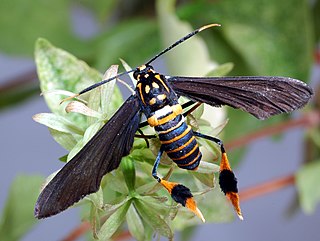
Horama is a genus of tiger moths in the family Erebidae first described by Jacob Hübner in 1819.

Arctia villica, the cream-spot tiger, is a moth of the family Erebidae. The species was first described by Carl Linnaeus in his 1758 10th edition of Systema Naturae. It is distributed from the Iberian Peninsula, Anatolia, western and northern Iran, western Siberia, southwestern Asia and North Africa.
Scoliosia is a monotypic moth genus in the subfamily Arctiinae erected by George Hampson in 1914. Its single species, Scoliosia brunnescens, was first described by Walter Rothschild in 1912. It is found in Papua and Papua New Guinea.
Striosia is a monotypic moth genus in the subfamily Arctiinae erected by George Hampson in 1914. Its single species, Striosia irrorata, was first described by Rothschild in 1912. It is found in New Guinea, where it is known from Papua and Papua New Guinea.
Tylanthes is a monotypic moth genus in the subfamily Arctiinae. Its only species, Tylanthes ptochias, is found in Australia and New Guinea. It is found in both lowland and highland habitats. Both the genus and species were first described by Edward Meyrick in 1889.

Drasteria is a genus of moths in the family Erebidae.
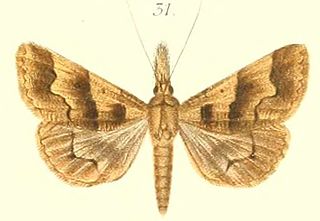
Ophyx is a genus of moths of the family Erebidae.
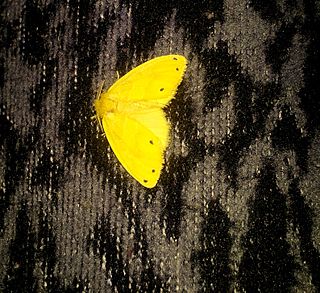
Artaxa is a genus of tussock moths in the family Erebidae erected by Francis Walker in 1855. Some of the species have urticating hairs.

Asota is a genus of moths in the family Erebidae first described by Jacob Hübner in 1819. Species are widely distributed throughout Africa, India, Sri Lanka, Myanmar, the Malayan region and tropical parts of the Australian region.

Lyclene reticulata is a species of lichen moths of the family Erebidae, subfamily Arctiinae. It is found in Queensland, Australia, as well as on Ambon, Seram, Timor, Batchian, Aru, Tobriand, the Louisiade Archipelago and the Dampier Archipelago,
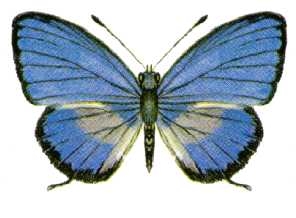
Nacaduba cyanea, the tailed green-banded line-blue, is a species of butterfly in the family Lycaenidae, and formerly considered a member of the genus Danis. It is found in the Indonesia, Papua New Guinea, the Solomon Islands and Australia (Queensland).
Semicalamidia is a monotypic moth genus in the family Erebidae erected by Rob de Vos in 2012. Its only species, Semicalamidia owgarra, was described by George Thomas Bethune-Baker in 1908. It is found in Papua New Guinea where its habitat consists of mountainous areas.
Ceryx ampla is a moth of the subfamily Arctiinae. It was described by Francis Walker in 1864. It is found on Aru in Indonesia and Papua New Guinea.
Damias elegans is a moth of the family Erebidae first described by Jean Baptiste Boisduval in 1832. It is found in Australia (Queensland), New Guinea and on Waigiou, Aru and the Trobriand Islands.
Nyctemera evergista is a moth of the family Erebidae first described by Stoll in 1781. It is found on the Moluccas, Seram, Buru and in New Guinea.
Avatha subpunctata is a species of moth of the family Erebidae first described by George Thomas Bethune-Baker in 1906. It is found on New Guinea and in Australia, where it has been recorded from Queensland.
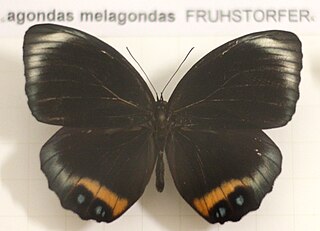
Elymnias agondas, the palmfly, is a butterfly in the family Nymphalidae. It was described by Jean Baptiste Boisduval in 1832. It is endemic to New Guinea and neighbouring Cape York in the Australasian realm.












